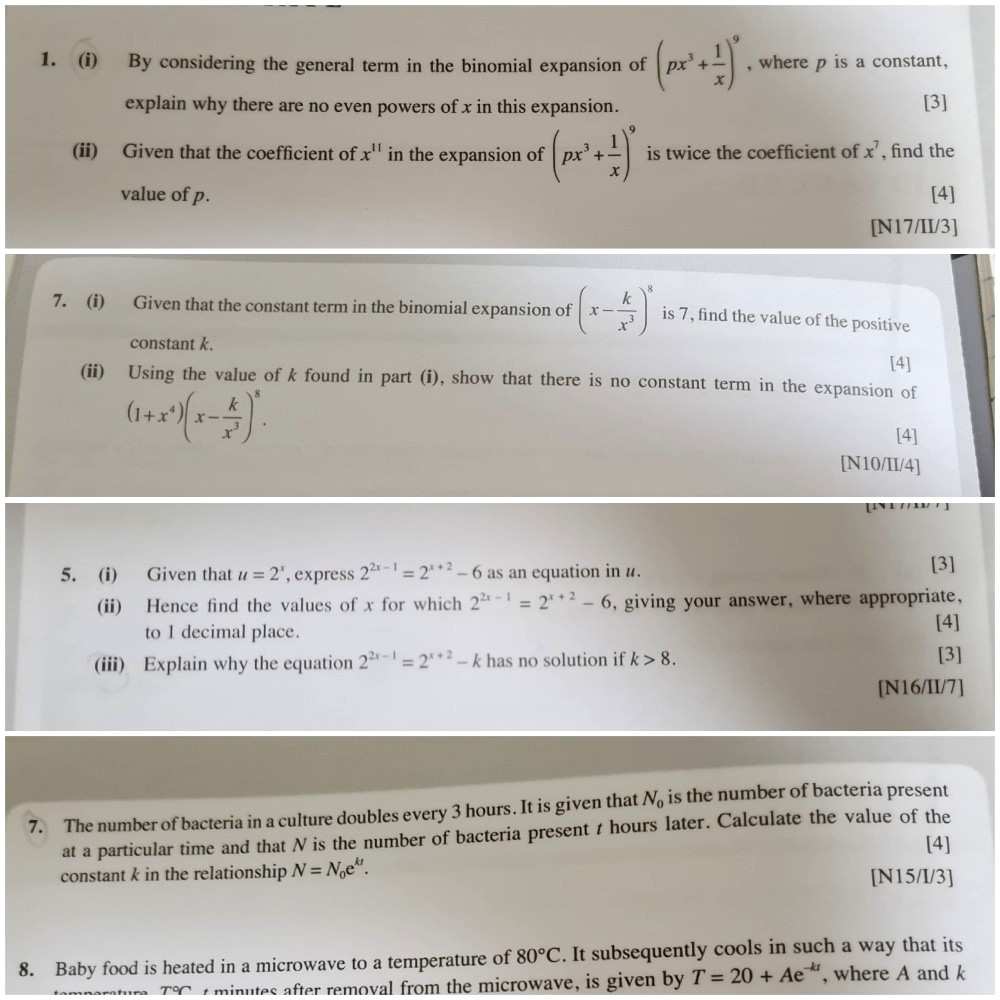Ask Singapore Homework?
Upload a photo of a Singapore homework and someone will email you the solution for free.

See 4 Answers
done
{{ upvoteCount }} Upvotes
clear
{{ downvoteCount * -1 }} Downvotes
Q1 of binomial theorem
Date Posted:
3 years ago
i dont really understand part (i) tho
The general term is used simply to single out a specific term in the expansion rather than expanding out fully. The formula for the general term is found in your formula sheet as (n r) a^(n - r) b^r.
We simply note that in this case n = 9, a = px^3 and b = 1/x before substituting these expressions into the said general term.
We combine all the powers of x into a single power of x to simplify the expression. The different values of r will give rise to the specific terms in the full expansion.
Of course, since our power found is 27 - 4r. and we know that odd - even cannot get us an even number, there will be no even powers of x at all in the expansion.
We simply note that in this case n = 9, a = px^3 and b = 1/x before substituting these expressions into the said general term.
We combine all the powers of x into a single power of x to simplify the expression. The different values of r will give rise to the specific terms in the full expansion.
Of course, since our power found is 27 - 4r. and we know that odd - even cannot get us an even number, there will be no even powers of x at all in the expansion.
thx :)
done
{{ upvoteCount }} Upvotes
clear
{{ downvoteCount * -1 }} Downvotes
Q7 of binomial theorem
Date Posted:
3 years ago
i dont really understand what they mean by leaving behind no constant term at part(ii)
When the full expansion of that product leaves behind no constant term, it can mean one of the following.
1. There is not even any individual constant terms at all as you multiply everything out (meaning all the terms contain x in the numerator or the denominator after individual simplification).
2. The constant terms do exist when you expand out everything, but they all cancel out (and therefore the constant term is "killed").
In this particular case, the product of 1 and 7, which is the constant term 7, is a surviving constant term in that expansion. If you work out the solutions, eventually you will find that the other constant term over there is -7, and this negates the earlier constant term of 7.
1. There is not even any individual constant terms at all as you multiply everything out (meaning all the terms contain x in the numerator or the denominator after individual simplification).
2. The constant terms do exist when you expand out everything, but they all cancel out (and therefore the constant term is "killed").
In this particular case, the product of 1 and 7, which is the constant term 7, is a surviving constant term in that expansion. If you work out the solutions, eventually you will find that the other constant term over there is -7, and this negates the earlier constant term of 7.
done
{{ upvoteCount }} Upvotes
clear
{{ downvoteCount * -1 }} Downvotes
Q5 of exponential equations
Date Posted:
3 years ago
do we always use b^2-4ac to determine whether an equation have real roots?
This applies only for quadratic equations, but this should be the first technique you look at as you determine the number of real roots of the equation.
done
{{ upvoteCount }} Upvotes
clear
{{ downvoteCount * -1 }} Downvotes
Q7 of exponential equations
Date Posted:
3 years ago








